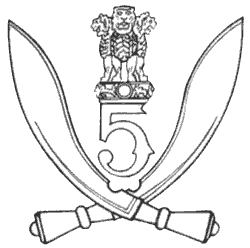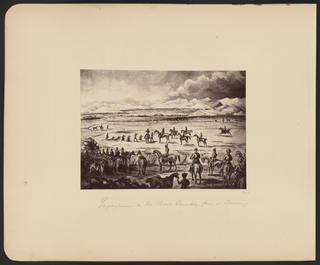
The Third Anglo-Afghan War began on 6 May 1919 when the Emirate of Afghanistan invaded British India and ended with an armistice on 8 August 1919. The Anglo-Afghan Treaty of 1919 resulted in the Afghans gaining control of foreign affairs from Britain and the British recognizing the Durand Line as the border between Afghanistan and British India. According to British author Michael Barthorp, it was a strategic victory for the British because the Durand Line was reaffirmed as the border between Afghanistan and India, and the Afghans agreed not to foment trouble on the British side. However, Afghans who were on the British side of the border did cause concerns due to revolts.

The Second Anglo-Afghan War was a military conflict fought between the British Raj and the Emirate of Afghanistan from 1878 to 1880, when the latter was ruled by Sher Ali Khan of the Barakzai dynasty, the son of former Emir Dost Mohammad Khan. The war was part of the Great Game between the British and Russian empires.

Major John Cook VC was a Scottish recipient of the Victoria Cross, the highest and most prestigious award for gallantry in the face of the enemy that can be awarded to British and Commonwealth forces. An officer of the Bengal Staff Corps who transferred to the 5th Gurkha Rifles, Cook was a veteran of the Umbeyla Campaign who received the VC posthumously for his actions during the Second Anglo-Afghan War.

The North-West Frontier was a region of the British Indian Empire. It remains the western frontier of present-day Pakistan, extending from the Pamir Knot in the north to the Koh-i-Malik Siah in the west, and separating the modern Pakistani frontier regions of North-West Frontier Province, Federally Administered Tribal Areas and Balochistan from neighbouring Afghanistan in the west. The borderline between is officially known as the Durand Line and divides Pashtun inhabitants of these provinces from Pashtuns in eastern Afghanistan.

The 3rd Gorkha Rifles or Third Gorkha Rifles, abbreviated as 3 GR is an Indian Army infantry regiment. It was originally a Gurkha regiment of the British Indian Army formed in 1815. This regiment recruit mainly Magars and Gurung tribes. They were present at a number of actions and wars including the siege of Delhi in 1857 to the First and Second World Wars. After the Partition of India in 1947 the regiment was one of the six Gorkha regiments transferred to the Indian Army as part of the Tripartite Agreement signed between India, Nepal and Britain at the time of Indian independence. Prior to independence, the regiment was known as the 3rd Queen Alexandra's Own Gurkha Rifles. In 1950 the regiment's title was changed to 3rd Gorkha Rifles. Since 1947 the regiment has participated in a number of conflicts including the 1947 and 1971 wars against Pakistan.

The 55th Coke's Rifles (Frontier Force) was a regiment of the British Indian Army. It was raised in 1849 as the 1st Regiment of Punjab Infantry. It was designated as the 55th Coke's Rifles (Frontier Force) in 1903 and became 1st Battalion (Coke's) 13th Frontier Force Rifles in 1922. In 1947, it was allocated to the Pakistan Army, where it continues to exist as 7th Battalion The Frontier Force Regiment.

5th Gorkha Rifles, also abbreviated as 5 GR(FF) is an infantry regiment of the Indian Army comprising Gurkha soldiers of Nepalese origin. It was formed in 1858 as part of the British Indian Army. The regiment's battalions served in the First World War (Mesopotamia) and Second World War.

The Battle of Ahmed Khel took place during the Second Anglo-Afghan War. It was fought on 19 April 1880, on the road between Kandahar and Kabul in central Afghanistan between Afghan tribesmen and soldiers of the British Empire, including forces from both British and Indian armies.

The India General Service Medal was a campaign medal approved on 1 March 1854, for issue to officers and men of the British and Indian armies. It was awarded for various minor military campaigns in India and nearby countries, between 1852 and 1895.

34°31′58″N69°09′57″E

The Peiwar Kotal Pass, also spelled Paywar, is a mountain pass in the Kurram Valley that connects Paktia Province in Afghanistan to Kurram District in the Khyber Pakhtunkhwa province of Pakistan.

The Afghanistan Medal, sanctioned on 19 March 1881, was awarded to members of the British and Indian armies who served in Afghanistan between 1878 and 1880 during the Second Afghan War, the first war being from 1839 to 1842.
The Peshawar Valley Field Force was a British field force. It was the largest of three military columns created in November 1878 at the start of the Second Anglo-Afghan War (1878-1880), each of which invaded Afghanistan by a different route. The Peshawar force initially consisted of around 16,000 men, a mix of both British and Indian Army regiments, under the command of Lieutenant General Sir Samuel J. Browne.

The 28th Punjabis were an infantry regiment in the British Indian Army. It was raised in 1857, as the 20th Regiment of Punjab Infantry. It was designated as the 28th Punjabis in 1903 and became 4th Battalion 15th Punjab Regiment in 1922. In 1947, it was allocated to the Pakistan Army, where it continues to exist as 12th Battalion The Punjab Regiment.

The 58th Vaughan's Rifles (Frontier Force) was an infantry regiment of the British Indian Army. It was raised in 1849 as the 5th Regiment of Punjab Infantry. It was designated as the 58th Vaughan's Rifles (Frontier Force) in 1903 and became 5th Battalion 13th Frontier Force Rifles in 1922. In 1947, it was allocated to the Pakistan Army, where it continues to exist as 10th Battalion The Frontier Force Regiment.
The Second Battle of Charasiab was fought on 25 April 1880 between the British Empire and Afghan tribesmen, during the Second Anglo-Afghan War.

The Kabul to Kandahar Star, also known as the Roberts Star or Kandahar Bronze Star was awarded to those British and Indian troops who participated in the 320 mile march from Kabul to Kandahar in Afghanistan between 9–31 August 1880, under the command of Lieutenant-General Sir Frederick Robertswho rode horseback on his horse Vonolel In addition, it was awarded to the troops stationed en route at Kelat-i-Ghilzie, who accompanied General Roberts on the final ninety miles to Kandahar.

The Kelat-I-Ghilzie Medal is a campaign medal issued by the British East India Company, to the defenders of the fort at Kelat-I-Ghilzie during the First Anglo-Afghan War.

The Battle of Charasiab was fought on 6 October 1879 during the Second Anglo-Afghan War between British and Indian troops against Afghan regular forces and tribesmen.

The Kurram Valley Field Force was a British military formation during the first phase of the Second Afghan War, 1878–79.


















